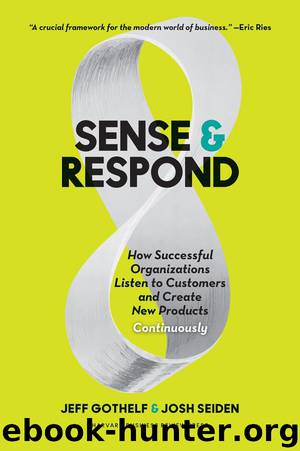Sense and Respond: How Successful Organizations Listen to Customers and Create New Products Continuously by Jeff Gothelf Josh Seiden

Author:Jeff Gothelf, Josh Seiden [GOTHELF JEFF, SEIDEN JOSH]
Language: eng
Format: epub
ISBN: 9781633691896
Publisher: Harvard Business Review Press
Published: 2016-12-05T05:00:00+00:00
Assessing the Cultural Impact
For this young company, this planning process was new; it replaced a different process it had used the year before, and still a different process from the year before that. So change was normal, but that doesn’t mean everyone liked it. Most of the managers appreciated the clarity as well as the flexibility to pursue their initiatives. And other product teams appreciated the clearly defined negative space: “We don’t have to work on that initiative, because it’s not on the road map.” But of course there were some hurt feelings, too. People didn’t like proposing initiatives that didn’t make the cut. Still, on balance, the process seems to have been a big step forward compared with earlier planning efforts.
Let’s review some of the elements that made this process successful and, at the same time, consider how it supports the sense and respond approach that this company embodies.
Strategy is expressed as intent. Rather than lay out a detailed plan, leadership set direction and asked the folks close to the customer to figure out the details.
Situational awareness defines tactics. The staff members have a deep knowledge of what the real-world conditions are, what they’d like to fix, and what is realistic. They were able to select the best tactics to achieve the mission.
Commitments are made to outcomes rather than features. By tying initiatives to outcomes rather than to features, leaders gave staff members the flexibility to pursue their missions and use their best judgment to achieve the desired outcomes.
A mix of bottom-up and top-down planning provides balance. Unlike previous years, in which bottom-up planning resulted in a lack of coordination—or, as we see in many organizations, top-down planning creates a lack of flexibility—this process balanced inputs to create a healthy equilibrium.
Download
This site does not store any files on its server. We only index and link to content provided by other sites. Please contact the content providers to delete copyright contents if any and email us, we'll remove relevant links or contents immediately.
Bad Blood by John Carreyrou(6274)
Rich Dad Poor Dad by Robert T. Kiyosaki(6175)
Principles: Life and Work by Ray Dalio(5961)
Playing to Win_ How Strategy Really Works by A.G. Lafley & Roger L. Martin(5499)
Management Strategies for the Cloud Revolution: How Cloud Computing Is Transforming Business and Why You Can't Afford to Be Left Behind by Charles Babcock(4438)
The Confidence Code by Katty Kay(4037)
Thinking in Bets by Annie Duke(3996)
American Kingpin by Nick Bilton(3507)
Delivering Happiness by Tony Hsieh(3280)
Project Animal Farm: An Accidental Journey into the Secret World of Farming and the Truth About Our Food by Sonia Faruqi(3018)
The Power of Habit by Charles Duhigg(2966)
Brotopia by Emily Chang(2896)
Mastering Bitcoin: Programming the Open Blockchain by Andreas M. Antonopoulos(2891)
The Tyranny of Metrics by Jerry Z. Muller(2846)
I Live in the Future & Here's How It Works by Nick Bilton(2844)
The Marketing Plan Handbook: Develop Big-Picture Marketing Plans for Pennies on the Dollar by Robert W. Bly(2793)
The Content Trap by Bharat Anand(2778)
Building a StoryBrand by Donald Miller(2754)
Applied Empathy by Michael Ventura(2750)
